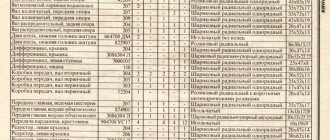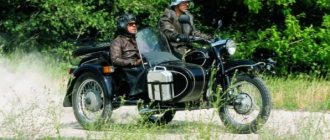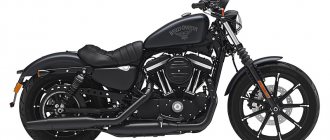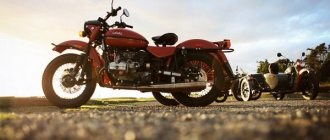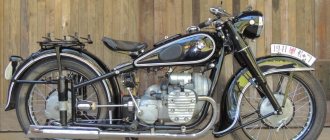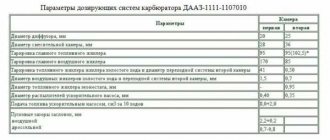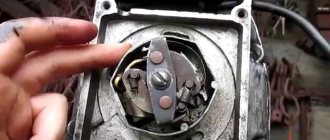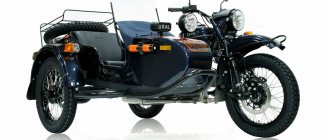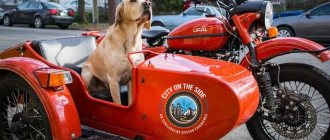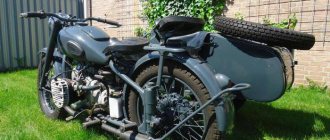Both “Dnepr” and “Ural” made a lot of noise in their time. These were powerful and sought-after motorcycles that many motorcycle enthusiasts dreamed of. In the Union, Dnepr and Ural competed much like Mercedes and BMW compete today. Of course, the names of Soviet motorcyclists are not so well known and popular today. However, previously these were widespread heavy motorcycles, used not only by motorcyclists in the Union, but also beyond its borders. Next, let's look at which bike was better, for what qualities this or that motorcycle was purchased, what advantages and disadvantages they had.
Engine
The design of the “Dnepr” and “Ural” was approximately similar, but there are still design differences. For example, one of the main differences is different crankshafts. On the Ural it was composite (assembled by pressing), non-separable, with roller bearings of the lower head of the connecting rod. This solution had several tangible advantages: a high degree of reliability, durability even in the absence of a sufficient amount of lubricant in the system. On the other hand, such a crankshaft was not strong enough. There are known cases of it turning at the pressing site. The crankshaft on the Ural cannot be repaired (in theory, you can unpress it, sort it out and reassemble it again, in practice no one does this kind of work).
But the Dnepr had a solid crankshaft, with plain bearings on the lower connecting rod heads. The connecting rods themselves are collapsible. In turn, such a design had the following advantages: durability of the liners; they are able to withstand increased loads, since they have an increased contact area with the shaft. If necessary, the Dnepr engine could be disassembled and the crankshaft repaired. But if for some reason the oil stops flowing in the required quantity, the liners will quickly wear out, which will lead to the need for repairs. It’s quite problematic to say for sure which bike is more reliable – “Dnepr” or “Ural”. Both one and the other had their serious disadvantages, as well as advantages.
What to choose
On modern roads, especially in the Russian expanses, you can’t go far in cars. An all-terrain vehicle is not accessible to everyone. All that remains is a scooter or a bicycle. However, there is another effective means of transportation, especially off-road - a motorcycle. The motorcycle is much better, faster and you can attach a stroller. Why not a car? Only without a roof, in the open air.
What brands and countries of manufacturers are there? Yamahas, Harleys, Urals, Bobbers and Choppers, Dnepr, Customs, BMWs and many others. Undoubtedly, each type of such technology has advantages and disadvantages, and this is not bad, there is plenty to choose from and something to compare with. You are offered the two most common domestic types of motorcycles, more affordable on our market and proven to be the best for riding especially off-road: the Ural and the Dnepr . True, during the division of the Soviet state, the Dnepr motorcycle remained in Ukraine.
Transmission
If we say that the Dnepr was still better, then mainly due to the gearbox. The most reliable unit was the MT-804 motorcycle. The gearbox received clear gears and was also particularly smooth. Many Ural owners remember with horror the gearbox on this motorcycle. She often brought big problems and troubles.
“Dnepr” became popular due to the presence of reverse gear. It worked without problems, turned on clearly, and the box actually didn’t cause any trouble. “Urals” with a gearbox in which there was a reverse gear also existed, but many owners noted that when they tried to engage reverse gear, neutral gear was engaged. Therefore, in terms of transmission, victory can be given to the Dnepr, on which the manual transmission was more reliable, unpretentious and generally successful in design.
What is the difference between Ural and Dnepr motorcycles: characteristics and differences
The prototype of a motorcycle is a bicycle. You can even take as a basis the invention of the wheel, which dates back more than one millennium. The wheel served as an impetus for the creation of the bicycle in 1817, then in 1869 a steam engine was installed on the bicycle and the result was a moped with a reserve of fuel in a special trunk - coal or firewood. There were no kerosene or gasoline engines at that time.
A similar motorcycle was built for the first time (officially recorded) by the American Lucius Copeland, in the period 1881 to 1884. He installed an internal combustion engine with a liter tank of gasoline and the result was what we see now on our roads.
“Dnepr” or “Ural” according to reviews from motorcyclists
If you look at the reviews of ordinary motorcyclists, you can note a certain equality of bikes, because the Dnepr has many fans, a huge number of people adored and still adore the Ural. There is an opinion that the Ural is a faster motorcycle, while the Dnepr is more powerful. Motorcyclists oh, and the Ural can be brought to ideal condition if you have the necessary amount of time and money. If you have the funds and desire, you can eliminate some factory defects and bring the bike to a good level. If you have a desire to improve your motorcycle, then you can purchase both one and the other - you will be guaranteed pleasure.
History of "Dnepr"
The first motorcycle under the Dnepr brand was released back in 1950. The last one from the “Chopper” series rolled off the assembly line in 1992. In 2000, they tried to revive production; a special modification of the motorcycle was created, which was supposed to be exported, but in the end less than three dozen such models were produced, which were later transferred to the Ukrainian motorized regiment, and the project was canceled. Now the plant is being converted into a business center, the equipment is being handed over to a scrap metal collection point, we can say that an attempt at another revival will not take place with almost a hundred percent probability.
What can be concluded
Disputes about which motorcycle is better, the Ural or the Dnepr, will continue to occur. It is worth considering that old motorcycles have already seen quite a lot, so there are fewer and fewer bikes in good technical condition every day. But when the Soviet-made Dnepr and Ural were “young”, in fact they only provided pure driving pleasure. If you decide to buy a Soviet motorcycle today, then you can safely take, for example, a “Ural”, if you like it better, but the gearbox puts you off. It will not be difficult to install the Dnepr box on this motorcycle and get rid of the hassle associated with this unit.
Ural IMZ 8.103-10.
Ural IMZ 8.103-10.
Dnepr K-650 (MT-8).
edit this post
Definition
Dnepr is a Ukrainian heavy motorcycle produced by the Kiev Motorcycle Plant.
Motorcycle "Dnepr"
Ural is a heavy Russian motorcycle produced by the Irbit plant.
Motorcycle "Ural"
Specifications
The Dnepr and Ural motorcycles were produced in several modifications - Dnepr -11; 12 and 16. Larger Urals: M62; 63; 66; 67; 67-36 and IMZ-8.103.
- The length of the Dnieper is 2420-2430 , the Urals - 2420 - 2490 .
- Width – Dnieper 1500 cm , Ural – 1650 cm .
- The height of the Dnieper and the Urals is 1100 cm .
- The speed is 95 – 105 km/h for both types.
- Weight: Dnepr - 330-355 kg ; Ural - 310-340 kg .
- Fuel consumption per 100 km. ways: Dnieper – 8, 7, 9 liters; Ural - 5.8; 6; 8 liters.
- All of them are four-stroke, carburetor, two-cylinder, air-cooled.
- Engine displacement: Dnepr – 650, 750 m3; Ural - 650 cm3.
- Power: Dnepr – 26; 32 hp ; Ural - 28-36 hp .
- Both have an oil-based air cleaner with two-stage cleaning.
- The gearbox is four-speed.
- Battery: 6-12v.
- Brakes: mechanical, shoe with friction linings.
- Fuel tank: 19-22 liters .
- Oil capacity in the engine crankcase is 2.0 - 2.3 liters.
- Gearboxes - 0.8 - 1.5 l .
- Air cleaner – 0.125 – 2.0 l .
- The frame is tubular.
- Front: telescopic fork with double-acting hydraulic shock absorbers.
- Rear suspension: initially spring, and then, after modification, lever suspension with double-acting spring-hydraulic shock absorbers.
- Clutch: dry double-disc, driven discs with linings on both sides.
- Reverse gear is available on both types of motorcycles. This is what unites them.
There are few external differences in the Dnepr and Ural motorcycles. After all, there was only one manufacturer - the Soviet Union . You cannot determine the quality of a motorcycle by external signs. And the design depends on the taste and color... And the technical characteristics, for the most part, are not far from each other. Each of them has both advantages and disadvantages. It must be said that with the division of the USSR state, little attention was paid to the improvement of motorcycles. They are improved by the owners themselves, as best they can. Naturally, without violating the factory technical data.
Motorcycles Dnepr and Ural belong to the category of heavy ones , although modern models are already lightweight due to the use of plastic and light alloys. components and parts in these models are interchangeable. That is, they fit together easily. For example: gearboxes, frames, many engine parts, shock absorbers, electrical equipment, clutch.
The electrical equipment is completely compatible with each other, even if the headlights and backlights are of different shapes. The diagram is important to you. The components are also identical: relay, magneto, ignition coil. Bridges of both types are externally different, but they fit together quite well and can be changed without any problems. If you are installing an axle from a Dnepr motorcycle to the Urals, then you need to move it together with the rear wheel. The shape and number of spokes are different.
It is better to replace the gearbox complete. In detail, there may be some discrepancies. For example, their driveshafts are different, the Dnieper’s are longer than those of the Urals, and the Urals’ have a composite driveshaft. The motors and power system can be installed without any modification. Their exhaust pipes are different, but the seats are the same. They removed the engine along with the pipes and completely rearranged it.
Motorcycle modifications
- M 72 (1950-1952). The very first model produced by the Kyiv Motor Plant. Structurally, it was an almost exact copy of the BMW R71.
- M 72N (1953-1957). Reinforced frame and wheels, new linkage fork, slightly modified engine and many minor changes.
- K-750 (1958-1962). An updated 26-horsepower engine, hydraulic shock absorbers, new sidecar suspensions and reduced fuel consumption.
- K-750M (1963-1967). An upgraded version of the previous generation.
- K-650 , aka MT 8 (1968-1970). A new overhead valve 650 cc engine with a power of 27 horses, allowing speeds of up to 100 km/h.
- MT 9 (1971-1974). It was practically no different from the previous model, except that it was with this generation that the installation of turn signals began.
- MT 10 (1974-1976). One of the most popular and widespread modifications. The 6-volt electronics have been replaced with 12-volt ones.
- MT 10 36 (1976-1978). It is a slightly modified version of MT10. The engine has increased in power - it has as much as 32 horsepower instead of 27.
- MT 12 (1978-1984). The first civilian version of the bike with a low-valve 750 cc engine.
- MT 11 (1984-1986). The appearance of a hand (parking) brake, as well as the stroller’s own braking system.
- MT 16 (1986-1991). Civil version with overhead valve 650 cc engine.
- KMZ 8.157.01 Solo (1991). The very first single motorcycle in the line, not initially equipped with a side trailer.
- KMZ 8.157.02 (1991). Improved speedometer, 9th axle, modified suspensions and other little things.
- KMZ 8.157.022 Chopper (1992). The latest model, released in a small edition. It differs from the previous modification mainly in its body kit. It is practically never found on sale due to its rarity.
There were other modifications that were of no interest other than purely historical, since they were either produced in small batches for sports teams, or were used as special equipment, and were not available for free sale.
Motor
Which engine is better - Ural or Dnepr? Over the years of production of both motorcycles, the engines have been changed and improved, but no modification of either of these motorcycles can be called extremely reliable and problem-free.
Of course, there were some specimens that could not break for decades, but this was more likely a matter of luck rather than a pattern. Let's say that it is easier and cheaper to find spare parts and components for the Ural engine in our time, so it wins in this matter.
Motorcycle price
The new Dnepr is understandably impossible to find, since production of the model ceased shortly after the collapse of the USSR. Used copies are usually sold, setting the price “out of the blue” - some want 5 thousand rubles, and others want all 50. But on average, a bike in “live” condition and with documents will cost from 25-30 thousand rubles or more . The price is reasonable, considering that you can’t buy a new motorcycle for a comparable amount, even a Chinese one.
To sum up
The dispute between Dnepr and Ural is forever. You need to understand that we are talking about quite old equipment, which is already pretty battered by life or the previous owner. In many ways, this debate about which is better will be decided by the condition of the specific specimens. But no one forbids you, for example, to buy a faster Ural and install a reliable box from the Dnepr on it, or come up with some similar option of your own.
Sources:
https://oppozit.ru/article103207.html https://vse-o-moto.com/voprosy-i-otvety/317-otlichiya-dnepr-i-ural https://zen.yandex.ru/media/ id/5be9b40435713d00aa21ce06/5c6bf351ef11b700af1e8548 https://zen.yandex.ru/media/id/5ca9b1a062221000b3113852/5ccfefe4fd2dc300af7bfb04 https://drive.temaretik.com/1579730 195781257525/chto-luchshe-dnepr-ili-ural-obzor-mototsiklov-harakteristiki- i-otzyvy/
Design
Early modifications outwardly look like twin brothers of German motorcycles - not surprising, since they were copied from them. Subsequently, the appearance changed several times, but only slightly, and an inexperienced biker is unlikely to distinguish the Dnieper from the Urals at first glance. In that era, no one thought about design, and technical characteristics were put at the forefront, not appearance.
